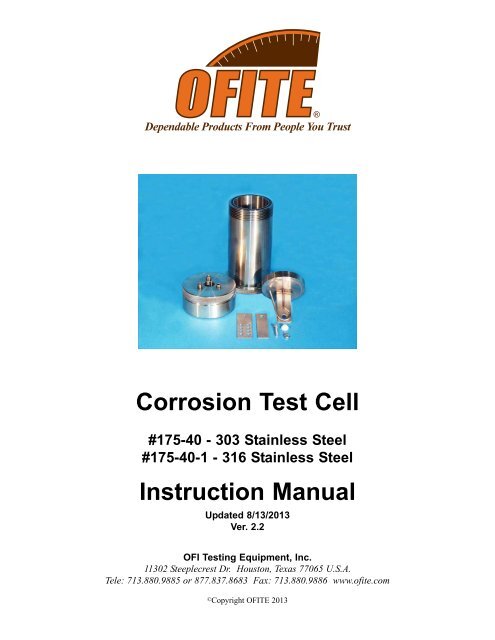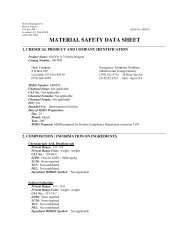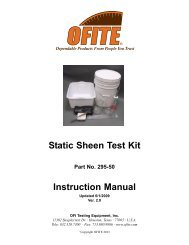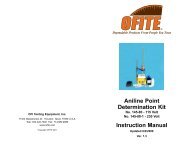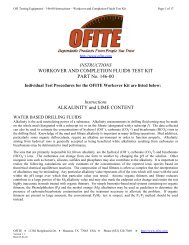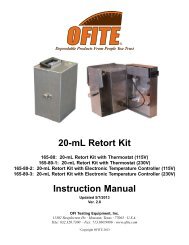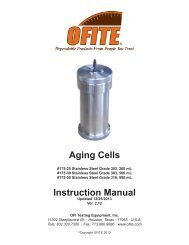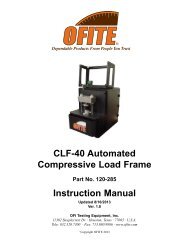Corrosion Test Cell - OFI Testing Equipment, Inc.
Corrosion Test Cell - OFI Testing Equipment, Inc.
Corrosion Test Cell - OFI Testing Equipment, Inc.
Create successful ePaper yourself
Turn your PDF publications into a flip-book with our unique Google optimized e-Paper software.
<strong>Corrosion</strong> <strong>Test</strong> <strong>Cell</strong><br />
#175-40 - 303 Stainless Steel<br />
#175-40-1 - 316 Stainless Steel<br />
Instruction Manual<br />
Updated 8/13/2013<br />
Ver. 2.2<br />
<strong>OFI</strong> <strong>Test</strong>ing <strong>Equipment</strong>, <strong>Inc</strong>.<br />
11302 Steeplecrest Dr. Houston, Texas 77065 U.S.A.<br />
Tele: 713.880.9885 or 877.837.8683 Fax: 713.880.9886 www.ofite.com<br />
©Copyright <strong>OFI</strong>TE 2013
Table of<br />
Contents<br />
Intro....................................................................................................2<br />
Description........................................................................................2<br />
Parts and Accessories.....................................................................3<br />
Specifications ...................................................................................4<br />
Procedure..........................................................................................5<br />
Calculations ......................................................................................7<br />
<strong>OFI</strong>TE, 11302 Steeplecrest Dr., Houston, Texas 77065 USA / Tel: 713-880-9885 / Fax: 713-880-9886 / www.ofite.com 1
Intro<br />
The <strong>OFI</strong>TE <strong>Corrosion</strong> <strong>Test</strong> <strong>Cell</strong> is a pressure vessel that has been modified<br />
to hold a special corrosion coupon suspended inside the cell to accurately<br />
analyze corrosion rates under carefully controlled conditions of elevated<br />
temperatures and pressures. <strong>Corrosion</strong> may be defined as the decomposition<br />
of the metallic state of an element. It is a process that, if untreated,<br />
continues until all of the metal turns to rust or decomposes into the oxide or<br />
salt that nature intended it to be. For iron based metals, namely steel,<br />
there is no known way of avoiding corrosion and it will happen whether we<br />
like it or not. The most we can do is to control it in a way that it does not<br />
happen rapidly, or concentrate in any one spot. It is a proven fact that uniform<br />
corrosion can and will accelerate if left uncontrolled. The best way to<br />
determine if this is occurring is to place a sacrificial surface (coupon) in the<br />
fluid path and observe its wear by weight difference.<br />
The <strong>OFI</strong>TE <strong>Corrosion</strong> <strong>Test</strong> <strong>Cell</strong> enables us to accurately monitor the<br />
amount of corrosion and also the rate at which it occurs. We also can<br />
accurately monitor the effectiveness of corrosion inhibitors under a carefully<br />
controlled environment. The amount of metal loss is directly proportional to<br />
the corrosivity of the fluid as the central mounting placement of the coupon<br />
within the cell ensures there is no erosion (frictional loss) and the coupon<br />
mounting effectively eliminates any galvanic corrosion.<br />
Description<br />
The standard <strong>OFI</strong>TE <strong>Corrosion</strong> <strong>Test</strong> <strong>Cell</strong> is manufactured from Stainless<br />
Steel in grades 303 (175-40) or 316 (175-40-1). For testing highly corrosive<br />
fluids, Hastelloy ® and <strong>Inc</strong>onel ® cells are available by special order.<br />
The special <strong>Corrosion</strong> <strong>Test</strong> <strong>Cell</strong> Inner Cap may be used with any of the<br />
<strong>OFI</strong>TE style 500 mL stainless steel Aging <strong>Cell</strong>s. The cap is designed to<br />
hold a flat <strong>Corrosion</strong> Coupon suspended inside the cell to prevent contact<br />
with the cell walls or any other metallic surface. The coupon is attached to<br />
the holder with a grommet which prevents galvanic corrosion from occurring.<br />
The flow of pressurized air or gas into the cell is directed away from<br />
the coupon to prevent erosion and possible injected contaminants which<br />
could adversely affect the coupon weight.<br />
Flat <strong>Corrosion</strong> coupons are typically used in aging cells in a laboratory<br />
environment or at select locations within the flow line. Coupons should<br />
never be handled without wearing protective gloves. The <strong>Corrosion</strong><br />
Coupon should be kept inside the cell for a minimum of 16 hours, with time<br />
periods of 40 or even 100 hours considered normal. Shorter exposure<br />
times should be avoided because initial corrosion rates may be unusually<br />
high and can give misleading data. After exposure to the fluid for a period<br />
of time the difference between the initial and the final weights (or the weight<br />
loss) is attributed to corrosion. The corrosion rate is calculated and reported<br />
as lbs/ft 2 /yr, or mils per year (my). The term “mils per year” refers to the<br />
loss of metal in thousandths of an inch per year.<br />
<strong>OFI</strong>TE, 11302 Steeplecrest Dr., Houston, Texas 77065 USA / Tel: 713-880-9885 / Fax: 713-880-9886 / www.ofite.com 2
Parts and<br />
Accessories<br />
Caps<br />
#175-13 Outer Cap for Pressurized Aging <strong>Cell</strong>s, 303 Stainless Steel<br />
#175-45 Inner Cap with Coupon Holder, 303 Stainless Steel<br />
#175-45-1 Inner Cap with Coupon Holder, 316 Stainless Steel<br />
O-rings and Gaskets<br />
For tests below 200°F:<br />
#175-54 Buna N O-ring for Outside of Aging <strong>Cell</strong><br />
For tests up to 400°F:<br />
#170-17 Viton ® O-ring for Valve Stem<br />
#175-09-2 Viton ® O-ring for Inside of Aging <strong>Cell</strong> Body<br />
#175-47 Viton ® O-ring for Outside of Aging <strong>Cell</strong><br />
For tests above 400°F:<br />
#175-09-1 Teflon ® O-ring for Inside of Aging <strong>Cell</strong> Body<br />
#175-46 Teflon ® O-ring for Outside of Aging <strong>Cell</strong><br />
#175-03 Peek O-ring for Inside of Aging <strong>Cell</strong> Body<br />
!<br />
Important<br />
Buna N o-rings should only be used for temperatures below 200°F.<br />
Viton ® o-rings can be used at temperatures up to 400°F.<br />
Teflon ® o-rings should be used for temperatures above 400°F.<br />
Set Screws and Wrenches<br />
#175-14 Set Screw for Pressurized Aging <strong>Cell</strong>s; 3/8"<br />
#175-15 Wrench for 3/8" Set Screw<br />
Other<br />
#175-05 Thrust Washer<br />
#175-16 Valve Stem<br />
#180-04 Grommets, Package of 10<br />
#180-12 <strong>Corrosion</strong> Coupon, 1/16" × 1" × 3"<br />
#180-34 <strong>Corrosion</strong> Coupon, 1/16" × 3/4" × 3"<br />
#175-40-SP Spare Parts Kit<br />
#165-44 High-Temperature Thread Lubricant, 1 oz, Qty: 2<br />
#170-17 O-ring for Valve Stem, Viton ® , 36<br />
#175-09-1 O-ring for Inside of Aging <strong>Cell</strong>, Teflon ® , Qty: 12<br />
#175-09-2 O-ring for Inside of Aging <strong>Cell</strong>, Viton ® , Qty: 12<br />
#175-14 Set Screw, 3/8", Qty: 6<br />
#175-15 Wrench for Set Screws<br />
#175-16 Valve Stem, Qty: 6<br />
#175-46 O-ring for Outside of Aging <strong>Cell</strong>, Teflon ® , Qty: 4<br />
#180-04 Grommet, Package of 10, Qty: 6<br />
<strong>OFI</strong>TE, 11302 Steeplecrest Dr., Houston, Texas 77065 USA / Tel: 713-880-9885 / Fax: 713-880-9886 / www.ofite.com 3
Specifications<br />
Maximum Temperature: 600°F (315°C)<br />
Maximum Pressure: 2,000 PSI (13.8 MPa)<br />
For tests above 200°F, refer to the chart below for the appropriate<br />
pressure.<br />
Mud Volume and Pressure for<br />
High-Temperature Aging<br />
Aging<br />
Temp.<br />
(°F / °C)<br />
Water<br />
Coefficient of<br />
Vapor<br />
Expansion of<br />
Pressure<br />
Water<br />
(PSI)<br />
Suggested<br />
Applied<br />
Pressure<br />
(PSI / kPa)<br />
Mud<br />
Volume in<br />
260 mL<br />
<strong>Cell</strong> (mL)<br />
Mud<br />
Volume in<br />
500 mL<br />
<strong>Cell</strong> (mL)<br />
212 / 100 14.7 1.04 25 / 172 225 450<br />
250 / 121 30 1.06 50 / 345 225 450<br />
300 / 149 67 1.09 100 / 690 200 425<br />
350 / 176 135 1.12 150 / 1,034 200 400<br />
400 / 204 247 1.16 250 / 1,724 - 375<br />
450 / 232 423 1.20 300 / 2,069 - 375<br />
500 / 260 680 1.27 375 / 2,586 - 325<br />
550 / 287 1,100 1.36 500 / 3,448 - 275<br />
600 / 315 1,543 1.47 500 / 3,448 - 250<br />
!<br />
Important<br />
!<br />
Important<br />
!<br />
Important<br />
Do not use nitrous oxide cartridges as pressure sources for high-temperature,<br />
high-pressure (HTHP) aging. Under high temperature and<br />
pressure, nitrous oxide can detonate in the presence of grease, oil, or<br />
carbonaceous materials. Nitrous oxide cartridges are to be used only<br />
for Garrett Gas Train Carbonate Analysis.<br />
Carbon dioxide and nitrous oxide cartridges are pressurized to<br />
approximately 900 PSI at 1 atmosphere (sea level). Therefore, they<br />
should never be transported by airplane without proper packing<br />
because cabin de-pressurization may cause an explosion.<br />
If the aging cells are going to be rolled in a roller oven during a test,<br />
install o-rings on the outer perimeter on the top and bottom of the<br />
cells. Failure to do so can damage the rollers in the oven. Teflon<br />
(#175-46), Viton ® (#175-47), and Buna N (#175-54) o-rings are available.<br />
<strong>OFI</strong>TE, 11302 Steeplecrest Dr., Houston, Texas 77065 USA / Tel: 713-880-9885 / Fax: 713-880-9886 / www.ofite.com 4
Procedure<br />
1. Carefully inspect all o-rings for defects. Place one o-ring in the groove<br />
inside the cell body and two in the grooves in the valve stems. Replace<br />
any o-rings that are hard or have cuts or nicks. Blow air through the<br />
valve stem to make sure it is not plugged.<br />
O-ring<br />
(#170-17)<br />
Valve Stem<br />
(#175-16)<br />
O-ring<br />
(#170-17)<br />
2. Attach the Nylon grommet to the hole in the corrosion coupon. Thread<br />
the supplied screw through the grommet and into the hole in the<br />
coupon holder on the inner cap. Secure it in place with the washer and<br />
nut. Be sure the corrosion coupon does not come in contact with any<br />
other metal surfaces.<br />
!<br />
Important<br />
Always handle the <strong>Corrosion</strong> Coupon with clean, dry gloves.<br />
Do not throw away or lose the “<strong>OFI</strong>TE Mailer” as this has the original<br />
weight (to 4 decimal places) and the serial number for the corrosion<br />
coupon.<br />
3. Carefully pour the test fluid into the cell. Clean any spilled fluid from<br />
the edge of the cell. Carefully place the special inner cap onto the cell<br />
body so that it seats into place. Hand tighten the outer cap into place.<br />
With the supplied Allen wrench, tighten the three set screws on top of<br />
the outer cap. Insert the valve stem into the inner cap and tighten it<br />
completely. To pressurize the cell, loosen the valve stem approximately<br />
one half turn and initiate pressurization.<br />
O-ring (#175-09-1)<br />
<strong>Test</strong> <strong>Cell</strong> (#175-30)<br />
Set Screw (#175-14)<br />
Inner <strong>Cell</strong> Cap<br />
(#175-45)<br />
Coupon Holder<br />
<strong>Corrosion</strong> Coupon<br />
(#180-12)<br />
Grommet (#180-04)<br />
<strong>OFI</strong>TE, 11302 Steeplecrest Dr., Houston, Texas 77065 USA / Tel: 713-880-9885 / Fax: 713-880-9886 / www.ofite.com 5
4. When the desired pressure is reached, close the valve stem by tightening<br />
it with the wrench. To ensure there are no leaks, immerse the cell<br />
in water and check for bubbles originating from the valve stem or cell<br />
cap.<br />
5. Place the <strong>Corrosion</strong> <strong>Test</strong> <strong>Cell</strong> into a heating oven or chamber and heat<br />
to the desired temperature or for the desired time interval.<br />
6. Remove the <strong>Corrosion</strong> <strong>Test</strong> <strong>Cell</strong> from the heating chamber and allow it<br />
to cool until the sample has reached ambient temperature. The cell<br />
may be either air or water cooled.<br />
7. When the cell has reached ambient temperature, open the valve stem<br />
very slowly to release the pressure. When the pressure has been<br />
released, open the cell.<br />
Note<br />
If the pressure inside the cell has not been fully released, the outer cell<br />
cap cannot be removed. This is a safety measure built into the Aging<br />
and <strong>Corrosion</strong> <strong>Test</strong> <strong>Cell</strong>s.<br />
8. Remove any fluid residue from the corrosion coupon by carefully wiping<br />
it with a cloth. Examine the coupon to determine the severity of the<br />
corrosion. If severe corrosion is evident, the cause should be determined<br />
and remedial action taken. The <strong>Corrosion</strong> <strong>Test</strong> cell is an ideal<br />
vessel for this analysis.<br />
9. As soon as possible, the cleaned coupon should be carefully weighed<br />
on a precision scale to four decimal places and the number noted as<br />
the final weight. This will be entered into the equation on page 6 to<br />
determine the amount of corrosive activity present. The <strong>OFI</strong>TE Mailer<br />
should be filled out with the final coupon weight and the coupon may<br />
then be stored in the mailer for future reference. If no scale is available<br />
that is accurate to four decimal places, the coupon may be mailed to<br />
<strong>OFI</strong> <strong>Test</strong>ing <strong>Equipment</strong> for re-weighing. There will be a nominal charge<br />
for this service. Mail the coupon to:<br />
<strong>OFI</strong> <strong>Test</strong>ing <strong>Equipment</strong><br />
11302 Steeplecrest Dr.<br />
Houston, TX. 77065 U.S.A.<br />
Please be sure to include your name, address, phone, and fax number.<br />
10. The <strong>Corrosion</strong> <strong>Test</strong> <strong>Cell</strong> must be thoroughly cleaned after every test.<br />
Clean out the valve stem with water and blow out any residual liquid<br />
from inside the stem. Clean out the cell body, paying particular attention<br />
to the o-ring and o-ring grooves. Carefully inspect the inner cell<br />
cap for residual liquid that may be trapped along or inside the air channel<br />
on the coupon holder.<br />
<strong>OFI</strong>TE, 11302 Steeplecrest Dr., Houston, Texas 77065 USA / Tel: 713-880-9885 / Fax: 713-880-9886 / www.ofite.com 6
Calculations<br />
lbs.<br />
Weight Loss (g)<br />
ft 2 = x K Factor<br />
Exposure Time (h)<br />
year<br />
lbs.<br />
mils per year (mpy) = ft 2<br />
x 24.6<br />
year<br />
The K Factor is a constant that contains the area and density of the corrosion<br />
coupon. The K Factor will be printed on the coupon packaging.<br />
A corrosion rate of 2 lbs/ft 2 /year or 50 mpy is a reasonable criteria for corrosion<br />
rate but this may vary with individual conditions.<br />
<strong>OFI</strong>TE, 11302 Steeplecrest Dr., Houston, Texas 77065 USA / Tel: 713-880-9885 / Fax: 713-880-9886 / www.ofite.com 7


